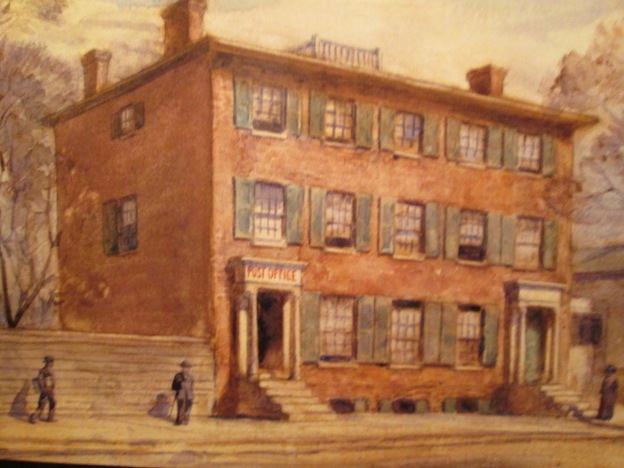Saturday March 7, 2015
Toronto turned 181 yesterday. On Thursday March 6, 1834 the town of York ceased to exist and was incorporated as the City of Toronto. At that time there were about 9,000 people in the city. That day the fourth post office of the town of York became the first post office of Toronto. The building has quite a history so I decided to go and check it out. It was minus 5 and sunny promising to get above freezing later in the day. I parked on Adelaide almost across the street.
The Bank of Upper Canada was chartered in 1821 and was instrumental in the development of York as the financial heart of the colony. In 1827 they opened their second home in a new building on the corner of George and Duke (Adelaide) streets in the centre of the town. The front portico was added around 1844 by John Howard, who owned Colborne Lodge. An expansion was added to the rear of the bank in 1851. The building in the picture below has a mansard roof dating to 1876.
In 1833 the bank sold Postmaster James Scott Howard 60 feet on the east end of Town Lot #6. Here he built a new post office and closed the one around the corner on George street. The cover photo shows a painting by Owen Staples called “Fourth York Post Office 1833-39” At this time the postal service was part of the British Royal Mail and being postmaster was by appointment. Having been born in Ireland in 1798 Howard had come to York in 1820. He became postmaster in 1828. Howard resided in the top of the building which originally had a flat roof. The picture below shows the restored building today.
Among James Scott Howard’s papers was a receipt from a contractor detailing the size and number of post boxes. This allowed for a more accurate restoration inside the building.
While I was there I bought a “penny ink well”. These were made in the thousands and used for writing along with a pen made of a flight feather of a large bird, also known as a quill. Quills were kept sharp with a pen (pocket) knife.
Howard would have stood behind a counter similar to the one below until the Rebellion of 1837 caused him to lose his position. William Lyon Mackenzie and the rebels had set out to march down Yonge Street, attack the Bank of Upper Canada next door, and steal the gold stored there. Howard was falsely accused of aiding the rebels and his job was taken away and given to Charles Albert Berczy. Charles was the son of pioneer Wiliam Berczy who founded the settlement of German Mills in 1794
In 1839 Berczy moved the post office to Front street and Howard sold the building to a hardware merchant who lived there until 1870. In 1871 it was sold to the Christian Brothers, a Catholic teaching school, who had bought the former Bank of Canada building in 1870. They immediately built the De La Salle Institute building between the two. Five years later they modified the windows with arches and realigned the floors to match the new building next door.
It served as an educational facility until 1926 when the United Farmer’s Co-operative bought the three buildings. They proceeded to brick those arched windows up and install floors that intersected them, turning the old post office building into a cold storage plant for eggs and dairy. They operated a food processing plant and kept their offices in the other two parts of the old school. After being abandoned in 1971 it was struck by a fire on June 30, 1978. By this time the early history of Toronto’s First Post Office was forgotten and the building slated for demolition.
The painting in the cover photo led to the decision to restore the building to it’s 1833 configuration and open it as an historic post office. Today it functions as a post office and free museum. It is the only existing British Royal Mail Building in Canada. By the time Canada Post was created in 1851 and the Three Pence Beaver stamp issued, the post office had moved from this location. The restored block with the post office on the right, school in the middle and Bank of Upper Canada building on the left.
Looking at the west end of the Bank of Upper Canada you can see three distinct phases of construction. The original bank building of 1827 stands at the front. In the middle, with the flat roof, is the 1851 addition to the bank. The rear portion with the mansard roof was added by the Farmer’s Co-operative in 1926.
Directly across the street from the old post office stands the 1874 building of Christie, Brown and Co., Canada’s largest manufacturer of biscuits. The original 3 story building was enlarged over the years finally being used in the mid 1950’s for a greeting card and paper company. In 1971 George Brown College bought the building. They kept the exterior walls and built a new educational facility inside. Today, the tradition of education started a hundred years earlier by the Christian Brothers in the old post office carries on in the historical building across the street.
Google Maps Link: Toronto’s First Post Office
Like us at http://www.facebook.com/hikingthegta
Follow us at http://www.hikingthegta.com











Pingback: Silverthorne Grist Mill – Meadowvale | Hiking the GTA
Pingback: The Don Narrows | Hiking the GTA
Pingback: Old Post Road | Hiking the GTA
Pingback: Milkman’s Lane | Hiking the GTA
Pingback: The Battle Of York – Apr. 27, 1813 | Hiking the GTA
Pingback: The Necropolis | Hiking the GTA
Pingback: Toronto Historic Places | Hiking the GTA
Pingback: Toronto’s Early Banks | Hiking the GTA
Pingback: Pre-Toronto Buildings of York | Hiking the GTA
Pingback: Oaklands | Hiking the GTA